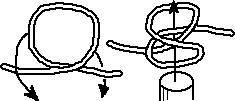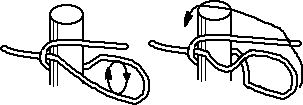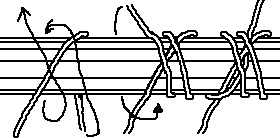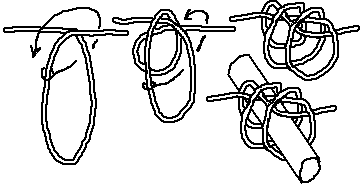![]()
Standard copyrights and disclaimer. The Constrictor Knot Family (
|
![]()
 The constrictor
knot is important as temporary whipping and as permanent binding from which you need more
than one in a row, but not in line (when you should use the strangle knot). Laid well, it
is virtually impossible to untie without tools (needle or knife). Never use it if you need
to untie it. It is almost the strongest among the 'simple' hitches. Only the double
constrictor is stronger. Because the constrictor may be tied in a bight, it is often
preferred over the strangle knot.
The constrictor
knot is important as temporary whipping and as permanent binding from which you need more
than one in a row, but not in line (when you should use the strangle knot). Laid well, it
is virtually impossible to untie without tools (needle or knife). Never use it if you need
to untie it. It is almost the strongest among the 'simple' hitches. Only the double
constrictor is stronger. Because the constrictor may be tied in a bight, it is often
preferred over the strangle knot.
 Lied in the bight, it is possible to use the constrictor virtually everywhere
where a permanent hitch is needed. In fact, it is my favorite permanent hitch.
Lied in the bight, it is possible to use the constrictor virtually everywhere
where a permanent hitch is needed. In fact, it is my favorite permanent hitch.
 One of the best
applications for this knot is the temporary whipping of ropestrands during marlinspiking.
With one yarn, you can easily whip more than one strand at the time. Once tied, you pull
them firmly all at once.
One of the best
applications for this knot is the temporary whipping of ropestrands during marlinspiking.
With one yarn, you can easily whip more than one strand at the time. Once tied, you pull
them firmly all at once.
 When you cannot place
the knot around the object after the knot is formed, you have to tie it round the object.
This may be difficult if you did not leave enough room to put the end through.
When you cannot place
the knot around the object after the knot is formed, you have to tie it round the object.
This may be difficult if you did not leave enough room to put the end through.
 For tieing a fence
rope, you can tie the constrictor in this interesting way. It allows working it up to
For tieing a fence
rope, you can tie the constrictor in this interesting way. It allows working it up to
one end while you maintain a limited force on the other end. So, you easily make a
straight rope fence (As long as your posts stand firm)
The Constrictor
Knot on the WEB.
The Transom Knot (Constrictor)
 Tied this way the constrictor is an excellent cross knot, called the
Transom Knot. (I used it for my kite when I was a kid). If you want to secure it, use two
closely laid overhand knots in both ends, or simply use a good kit or glue. An extra knot
above this knot does not have much effect. If more strength is required, tie another
Transom Knot on the back.
Tied this way the constrictor is an excellent cross knot, called the
Transom Knot. (I used it for my kite when I was a kid). If you want to secure it, use two
closely laid overhand knots in both ends, or simply use a good kit or glue. An extra knot
above this knot does not have much effect. If more strength is required, tie another
Transom Knot on the back.
The Transom Knot (Marlin)
 Tied this way
the Marline Hitch is an even better cross-knot as the
previous version of the Transom. It is not possible for the half-knot to work itself
between both rods where it is not held by the overlaying rope. Therefore, it is a better
cross knot than the constrictor-version of the Transom. (Thanks for the comment! I wish I
knew this as a kid. On the other hand I did not have any trouble with the constrictor
version. But I argree this is better.)
Tied this way
the Marline Hitch is an even better cross-knot as the
previous version of the Transom. It is not possible for the half-knot to work itself
between both rods where it is not held by the overlaying rope. Therefore, it is a better
cross knot than the constrictor-version of the Transom. (Thanks for the comment! I wish I
knew this as a kid. On the other hand I did not have any trouble with the constrictor
version. But I argree this is better.)
The Transom Knot on
the WEB.
 This
is the strongest and most secure simple hitch. If the single constrictor does slip (on
very slippery material) you can try this knot. If you make more turns round the enclosed
half knot or if you twine the half knot one wrap extra it makes the total result weaker.
That is probably because it makes it impossible to pull the knot as tight as this one. I
always use the double constrictor to "strangle" tubes tight on a pipes. Tubes
are often made from "slippery" materials.
This
is the strongest and most secure simple hitch. If the single constrictor does slip (on
very slippery material) you can try this knot. If you make more turns round the enclosed
half knot or if you twine the half knot one wrap extra it makes the total result weaker.
That is probably because it makes it impossible to pull the knot as tight as this one. I
always use the double constrictor to "strangle" tubes tight on a pipes. Tubes
are often made from "slippery" materials.
The Double Constrictor tied in the bight.
 If the
end of the object which you want to lay the double constrictor on is free, it is best to
tie the knot in the bight. If you master this technique it is much faster. Practice and
check yourself after the first turn. If that resulted in the single constrictor instead of
the clove hitch you started the wrong way.
If the
end of the object which you want to lay the double constrictor on is free, it is best to
tie the knot in the bight. If you master this technique it is much faster. Practice and
check yourself after the first turn. If that resulted in the single constrictor instead of
the clove hitch you started the wrong way.
![]()
Because this is an non-comercial site I can and will not allow junk mail nor spam. Therfore commercial, non-personal and bulkmail will be charged with handling costs of $100 per mail.